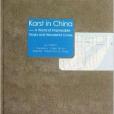《中國的喀斯特:奇峰異洞的世界》分為喀斯特類型及發育條件、喀斯特洞穴與發育過程、喀斯特作用與發育機理、喀斯特演化與建設效應、喀斯特分區與發育規律五大部分,通過大量喀斯特景觀照片,結合科技型圖表和文字論述,揭示了我國喀斯特發育的特徵及規律,反映了我國喀斯特地區的建設成就,並總結出有關喀斯特地區地質基礎的處理經驗。
基本介紹
- 中文名:中國的喀斯特:奇峰異洞的世界
- 作者:盧耀如
- 出版社:高等教育出版社
- 出版時間:2012年7月1日
- 頁數:378 頁
- 開本:8 開
- ISBN:9787040338904
- 外文名:Karst in China:A World of Improbable Peaks and Wonderful Caves
- 語種:英語
內容簡介,圖書目錄,
內容簡介
《中國的喀斯特:奇峰異洞的世界》由高等教育出版社出版。
圖書目錄
The Introduction to the Basic Karst Features and the History of Karst Research in China
Ⅰ Basic factors and conditions ofkarst development
(Ⅰ)Lithologic character of soluble rocks
(Ⅱ)Dissolution capacity of water
Ⅱ Major factors that affect karst development
(Ⅰ)The effect of geological structures on karsl
development
(Ⅱ)The effect of climatic factors on karst development
Ⅲ Characteristics of the karst geo-environment
(Ⅰ)Resources
(Ⅱ)Hazards
Ⅳ A brief history of karst investigation, research and development in China
(Ⅰ)The history of karst research in China
(Ⅱ)Progress in karst survey and research since the founding of the People's Republic of China
(Ⅲ)The direction of karst research in the future
Part Ⅰ Karst Types and Development Conditions
Ⅰ Carbonate Rock Karst(bare and semi bare)CRK
(Ⅰ)General Corrosion(Holokarst)Karst Type(K)
(Ⅱ)Partly Corrosional(Special Structural)Merokarst Type(KS)
(Ⅲ)Hydrothermal Rugged Karst Type(MK)
(Ⅳ)Corrosion-Glaciation Karst Types(KI)
(Ⅴ)Corrosion-Denudation Karst Type(KD)
(Ⅵ)Corrosion-Erosion Karst Type(KE)
(Ⅶ)Corrosion-Abrasion Karst Type(KA)
Ⅱ.Buried Carbonate Karst(CK and BK)
Ⅲ.Sulphate Karst(SRK)
Ⅳ.Halide Rock Karst(HRA)
Ⅴ.Homologous Karst(PK)
Part Ⅱ Karst Caves and Their Processes of Development
Ⅰ Famous karst caves
(Ⅰ)Ludi Yan Cave, Guangxi
(Ⅱ)Yao Lin Cave, Zhejiang
(Ⅲ)Yuhua Cave, Fujian
(Ⅳ)Shihua Cave, Beijing
Ⅱ.The most beautiful caves
(Ⅰ)Zhijin Cave, Guizhou
(Ⅱ)Furong Cave, Chongqing
(Ⅲ)Huanglong Cave, Hunan
(Ⅳ)Tenglong Cave, Hubei
(Ⅴ)Xueyu Cave, Chongqing
(Ⅵ)Shuidong Cave, Benxi, Liaoning
Ⅲ Distinctive caves
(Ⅰ)The longest cave system Shuanghe Cave in Guizhou
(Ⅱ)The deepest cave system
(Ⅲ)'Hot Cave' system
(Ⅳ)Summer ice cave system
Ⅳ The characteristics of water flow in caves and related morphology
(Ⅰ)Subsurface streams
(Ⅱ)Underground rivers
(Ⅲ)Underground waterfall(Dark waterfall)
(Ⅳ)Underground lakes and pools
Ⅴ The mechanism of mixed(three-phase)flow and the forms that they create in caves
(Ⅰ)Mechanical characteristics of gas-phase flow
(Ⅱ)Three-phase flow evolution in a cave roof
(Ⅲ)Lateral erosion in caves
(Ⅳ)Roof erosion in caves
(Ⅴ)Erosion and corrosion on the bottoms of cave passages
Ⅵ Some distinctive deposits in caves
(Ⅰ)Deposits in cold conditions
(Ⅱ)Sedimentation in hydrothermal water
(Ⅲ)Biological sedimentary activity in caves
(Ⅳ)Deposition by mixed reactions in caves
Ⅶ Flowing water travertine(speleothem)deposition in normal temperatures
(Ⅰ)Deposits of seepage water
(Ⅱ)Deposits of tubular water flow
(Ⅲ)Deposits of fissure water flow
(Ⅳ)Deposits of schistose water flow
(Ⅴ)Deposits of floor flow
(Ⅵ)Deposits of capillary water flow
(Ⅶ)Deposits of splashing water flow
(Ⅷ)Deposits of condensation water flow
(Ⅸ)Deposits of static water body
(Ⅹ)Deposits oflnixed water flow
Ⅷ.Paleokarst caves
Ⅸ.Deformation of caves
Ⅹ.Living organisms in caves
Ⅺ.Caves and human beings
Ⅻ.Non-carbonate karst caves
……
Part Ⅲ The Processes of Knrst Development
1.Classification of soluble minerals and their characteristics
Ⅲ.Corrosion, corrosional grooves and other markings on rock faces
Ⅳ Phenomena of focused corrosion
Ⅴ Processes of karst geomorphic development
Ⅵ.Processes of cave development
Ⅶ.Processes in karst groundwater
Ⅷ.Karst chemical deposits
Part Ⅳ Karst Environmental Evolution and Impacts of Construction
Part Ⅴ Regional Types and Variations in Karst Development

